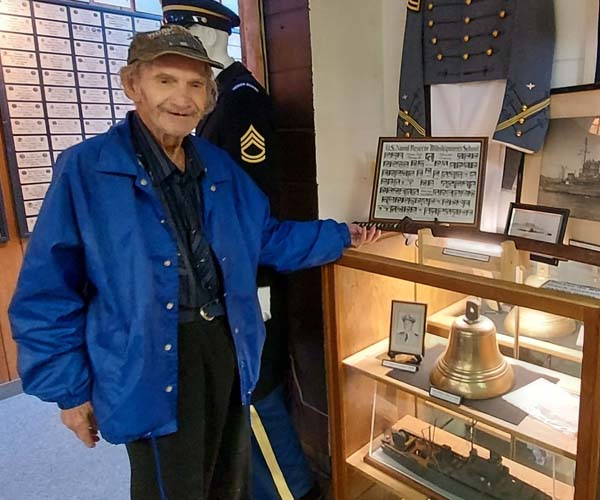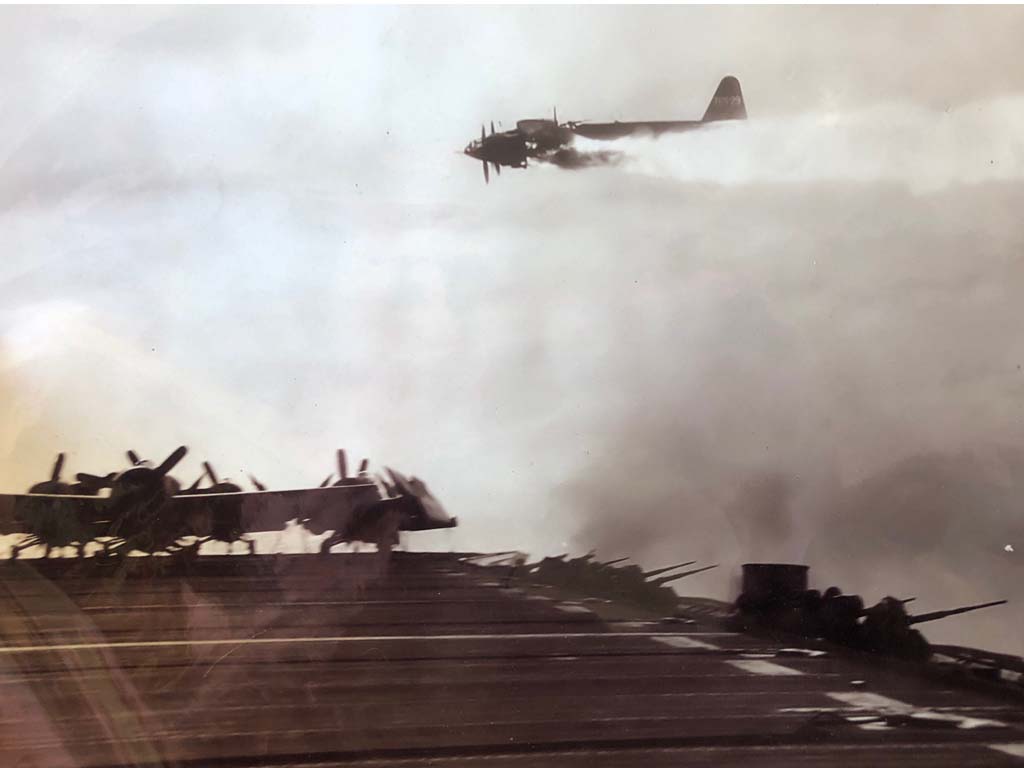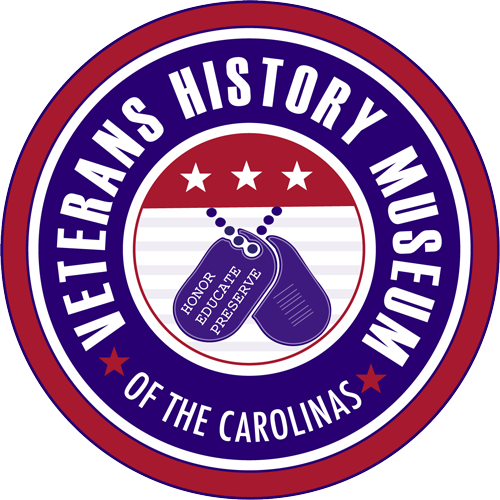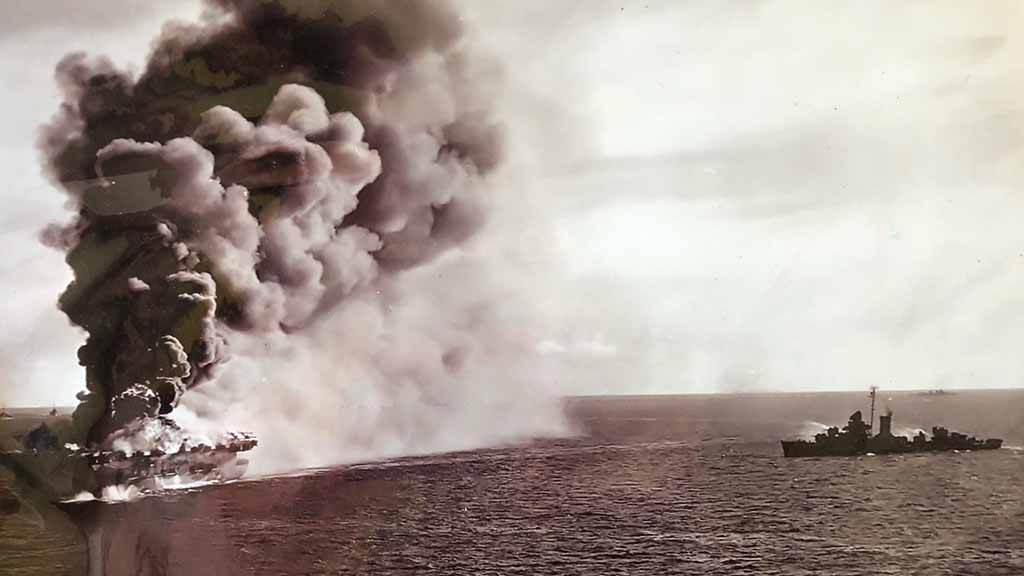Japanese “Betty” on fire. Photo courtesy Joe Cooper.
Joe Dayton Cooper
U.S. Navy, WWII – Pacific
December 27, 1941—December 28,1945
U.S. Army, Berlin Air Lift
Korean War, 1948-1953
Brevard resident Joe Cooper served in the U.S. Navy during WWII (Pacific), December 27, 1941—December 28,1945. After WWII ended, Cooper joined the U.S. Army, serving in Europe during the Berlin Air Lift and then back to the Pacific to serve in the Korean War, 1948-1953. Cooper tells his story:

Joe Cooper shares his knowledge of Japanese Samurai swords displayed in the Veterans History Museum in 2022.
“My name is Joe Dayton Cooper. I am 99 years old. I will be 100 on July 6, 2022. I was born in Asheville, but my dad moved to Brevard when I was four years old and opened a garage. He was an auto mechanic. He served in World War One. He was an engineer. That’s where he learned his trade. He was a good dad. He was a metal smith. He could make knives, swords—you ought to see the tools—he made screwdrivers, all kind of stuff.”
Attack on Pearl Harbor
“When the Japanese attacked Pearl Harbor, I was at Camp Straus in Brevard. After that, I joined the Navy. I went in the Navy because I was too young and they wouldn’t take me in the Marine Corps. They said, ‘We don’t take kids in here. Go home and grow up.’ The Navy said, ‘We’ll feed you eggs and milk.’ I was five feet six and 110 pounds.
“I had two brothers. They were in the Navy. One worked in a shipyard, and in ’44, he went in the Navy. We grew up poor. We ate three meals a day, but it was mostly beans and cornbread and buttermilk. They fed us good in the Navy.
In the Navy
“I went to training in Norfolk, Virginia. I was in Platoon 361. I still remember that platoon. I worked up as a gunner’s mate. I went to the gunner’s school across from Pearl Harbor. We had to learn the ammunition first, how to handle ammunition. Then we learned about the guns. We shot at drones that were five feet wide and remote-controlled.
“I was shooting a 50-caliber and a 75. The highest was eight-inch. They had sixteen-inch out there, but I never did get to fire one of them. I fired the 40-millimeter twin barrel. It was a Swedish gun. I was assigned to the submarine fighter USS PC (“Peter Charley”) 477 for 17 months—Midway, Guadalcanal, New Guinea. It was built like a destroyer.”
Hunting Submarines
We hunted submarines. We took our training in the Gulf of Mexico dropping depth chargers. Later on, they put rockets on the bow—two of them—one on port and one on starboard. We’d fire, and they wouldn’t go off till they hit something under the water.
“They sent us to New Guinea, then to Cairnes, Australia. I took a train to Sydney, then went on to troop ship Mount Vernon. It was on the USS George Washington luxury liner before it was converted to the Mount Vernon troop ship. Then to San Francisco and was assigned to the USS Ommaney Bay. That was one of the escort carriers.”
I Was a Plank Owner
“I met Henry Kaiser, who built the escort carriers, during the commissioning. I got papers that showed I was a plank owner of the USS Ommaney Bay. I was one of the first crew members on the ship when it was commissioned in San Francisco. I became a twin 40-millimeter gunner on the left side.”
“We were bringing a P-61 2-wing night fighter Blackhawk to Brisbane. We made an emergency cruise to Sydney, Australia. We were testing the boiler run wide open to avoid submarines. Took some P-47 Thunderbolts to Brisbane and a P-61 back with us. The twin night fighter had radar. Then we went to Alaska and then to the Hawaiian Islands. Then we took the Army 81st Wildcat Division and went to Guadalcanal and picked up the First Marine Division. We landed in the Palau Islands, south of Leyte. Palau means ‘tall tales’ in Spanish.”

The USS Ommaney Bay blows up after being attacked by a kamikaze. Photo courtesy Joe Cooper.
CliPart two of Joe Cooper’s story will appear in a future issue.We Got All the Japanese Planes Down
“It was September 1944. We were close support. We went in 14 days before the landing craft. The cruisers and battleships bombarded, and we offered air cover for them and bombed inland. That was the first time I fired the 40-millimeter in combat. The Japanese planes were attacking.
The planes were attacking, but we got ‘em all down. They didn’t do any damage. Bill Halsey said to bypass the island because it wasn’t worth it. Admiral Nimitz overruled him and we attacked anyway. The Marines were mad about it because it cost lives.
The Battle of Leyte Gulf
“I have a picture of a Japanese ‘Betty,’ just like a B-25 and B-26. [Mitsubishi Navy Type 1 attack bomber]. We were there about a month. Then we had to go to The Philippines—Leyte, October 24. We were softening up Leyte for the invasion of The Philippines—MacArthur’s return. There the Japanese started the kamikaze—suicide bombing. And then we had that big sea battle out there, at the Battle of Leyte Gulf. They wasn’t modernized like our battleships.”
The Battle of Surigao Strait, The Philippines
“We couldn’t tell what was a bomber and what was a kamikaze. They’d come there three and four at a time and one would go back and report what they’d done. Three of them would dive on us. They dropped torpedoes. In the picture of the plane we shot, it’s on fire, it did a barrel roll and hit about 200 yards from us in the ocean. The Ommaney Bay didn’t suffer any damage during the Battle of Leyte Gulf. We stored 24 torpedoes on the bulkhead down there. That was the closest call we had, but we were lucky. A lot of ships got hit. Our destroyer escort got sunk.”
Battleship Yamoto Destroyed
“The big Japanese battleship Yamoto was destroyed—eight Jap battleships in the battle off Okinawa. The planes from our carrier were attacking it. We were attacking it. We saw it happen.
“In December of 1944, we pulled out of The Philippines, went back to Admiralty Islands and got supplies to go through the strait to Mindoro to support the Marines. That’s where we got hit. When the sun went down, we launched planes to look for submarines. We changed positions with another aircraft carrier. The aircraft motors were running—anti-submarine.”
Kamikaze Attack
“Here come the ‘Betty’ kamikaze, making an attack on us. It dove, trying to hit the island [of the ship]. It missed it and went right through the middle of the ship. One 1400-pound bomb went in the engine room and knocked the power out. The other one hit the hangar deck. It was on fire in the stern of the ship.
“I was finishing a meal when it happened. A friend of mine saved my life. He said, ‘Let’s go down to the crew compartment. We’d just got down there, and there was a big BOOM, I thought it was a torpedo. Smoke started coming out of the bulkhead and the lights went out. We went up to the hangar deck and saw a plane exploding, hitting the bulkhead. We tried to get up to where the pilots were. We heard hollering up there. The pilots must’ve been trapped. Most of the people on the hangar deck were killed. We couldn’t get through because the doors were locked. So we went back down and then back up through another hatch on the port side.”
“We started throwing ammunition off.”
“We started throwing ammunition off and everything. I saw one man laying there with his leg off. I couldn’t help him. I saw one with a hole in his throat and blood was gushing out. He was running, hollering. There were explosions happening everywhere. I knew I had to get out as quick as I could. We had a lot of ammunition and thousands of gallons of gas on that ship. I said to myself, ‘I better get off before it blows up.’
“They were passing the word to jump. They said it wasn’t no good—everybody over the side. It was about 65 feet, so I just went over the side. I wasn’t scared of heights, I just wanted to get off of there. I didn’t have a life jacket on. My life jacket was down there by my gun. I jumped off the port bow.”
Joe Cooper will be honored by the Veterans History Museum of the Carolinas during and after Brevard’s Memorial Day parade on May 30. Cooper will ride in the WWII Jeep during the parade and meet members of the public in the museum after the parade to sign free copies of his story.
Click here to read Part two of Joe Cooper’s story
Joe Cooper, WWII and Korean War Veteran
Interviewed by Andrew Biggio & Michael McCarthy
Written by Janis Allen for the Transylvania Times

